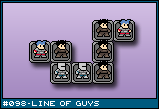|
Mechanic #098 - Line of Guys |
 | Posted: 02/21/09
A game mechanic which involves building a linear selection of characters and snaking them through tactical combat. |
|
The Line Forms At the Rear |
![[dw3a.png]](set05/img/entry098-dw3a.png)
![[dw3b.png]](set05/img/entry098-dw3b.png)
Dragon Quest III says 'Hello'
I've been playing some old school Dragon Quest games recently (and Guadia Quest from Retro Game Challenge), and despite being struck by how such decidedly old school games have really managed to stand the test of time, I've become obsessed with the way the little characters follow each other around on the maps. It's such a small detail in the grand scheme of things (to the point where few other RPGs bother following its lead), but I couldn't help but think, "hey, there's a really kick ass game here".
For those of you uninitiated in the ways of the Dragon Quest line, basically, all your party members follow around the lead character, kind of like a snake. In Dragon Quest III, your party members are selected by you from a set of classes, to the point where your party composition and even order is directly represented as a party as you walk around town. If one of your characters dies, he is replaced by a little adorable coffin.
|
Old School Made New School |
To sum up my mechanic, basically, this snake of characters becomes a physical thing on a game map (such that the shape affects the locations of the characters on a tactical map) and the relationship between each unit in the line and his neighbors matters. In other words, it's similar to [#017 - Composition Army], but with a snake.
![[snake1.png]](set05/img/entry098-snake1.png)
Here's a quick example. You are playing the snake of characters on the left. You control only the "head" (Maxim). The characters behind him will follow in the exact path that he travels. Since his party members are solid, he can not move through them. As you can see in this picture, two of the archers have line of sight to the enemy, while the third is blocked by the head character. The two knights at the end are melee characters, thus cannot attack because no enemies are in adjacent squares.
There are a few rules to how the snake operates:
You control the head or the tail of the snake to go forward or backward. The bottom of the screen will display the unit order of your battle line so the snaking doesn't obscure it.
You can swap adjacent characters' positions in line. This takes a single action. You can swap two characters that are touching, even if that are at different points in the battle line.
You can add or remove units to the ends of the snake. You can replace a character in the middle via a swap with a touching non-affiliated unit. There is no insert. Only replace and pushing / popping at the ends.
The snake can be broken, either by choice or by the death of a middle character. Trailing characters after the break will stay where they are, but otherwise fully active (will still attack and defend). You can add them all back with a single append action.
Your followers are solid. You cannot walk through them. You cannot move back to the square you were just in. If you are not careful, this can lead to getting boxed in, Tron Lightcycle style. If this happens, either break the line or switch head / tail control.
You can move either as a line or as a formation. In formation, all characters move as one instead of following the leader. Find a formation you like and keep it while navigating the map.
Units have abilities based on their position in the map. A cleric might heal all allies in the eight adjacent squares. Contort the snake to make the most of this. Archers will fire in a straight line at any enemy they can see. You do not control the units directly. You manipulate their positions and let the environment control them.
Units have abilities based on what units are next to them in the battle line. Two archers in a row might increase accuracy. Three more so. Knights can defend the units on either side of them. Knights hate mages, so putting them next to each other may lower both of their effectiveness. Heroes make units on either side of them fight better. Wind mages don't do very well next to earth mages, nor fire next to water. Named heroes may have storyline-based abilities, like a girl with a crush who does better next to a certain boy or two characters who don't like each other refusing to stand next to each other in line. |
![[dw3a.png]](set05/img/entry098-dw3a.png)
![[dw3b.png]](set05/img/entry098-dw3b.png)
![[snake1.png]](set05/img/entry098-snake1.png)
